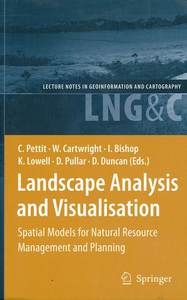Assessing water quality impacts of community defined land use change scenarios for the Douglas Shire, Far North Queensland
Bohnet, Iris, Brodie, Jon, and Bartley, Rebecca (2008) Assessing water quality impacts of community defined land use change scenarios for the Douglas Shire, Far North Queensland. In: Pettit, Christopher, Cartwright, William, Bishop, Ian, Lowell, Kim, Pullar, David, and Duncan, David, (eds.) Landscape Analysis and Visualisation: spatial models for natural resource management and planning. Springer, Berlin, Heidleberg, pp. 383-406.
![[img]](https://researchonline.jcu.edu.au/7399/2.hassmallThumbnailVersion/7399_Bohnet_et_al_2008.jpg)
|
Image (JPEG) (Book Cover)
- Cover Image
Download (169kB) |
|
|
PDF (Published Version)
- Published Version
Restricted to Repository staff only |
Abstract
The Douglas Shire is promoted as the only place in the world where two world heritage areas meet — the Great Barrier Reef (GBR) and the Wet Tropics of Far North Queensland. Over 80% of the shire's land area is World Heritage listed. On the remaining 20%, economic pressures on primary industries coupled with development pressures to subdivide agricultural land for urban and rural residential expansion provide a challenge not only for local people living in the shire, but also for planners and natural resource managers who have a responsibility to implement the Reef Water Quality Protection Plan (Reefplan) (Commonwealth and Queensland Governments 2003). The purpose of the Reefplan is to develop actions, mechanisms and partnerships to halt and reverse the decline in the quality of water flowing in the Great Barrier Reef lagoon.
The research presented in this chapter contributes to this goal by applying a social—ecological framework that links biophysical and social science data and is based on partnerships and local collaboration to achieve sustainability outcomes. This chapter focuses, in accordance with the Reefplan, on water quality and summarises the water quality impacts resulting from six spatially explicit land use change scenarios that were developed in col laboration with the local community in the Douglas Shire for the year 2025, based on their aspirations for a sustainable future. The spatially explicit land use change scenarios were used as input into the Sediment River Network Model (SedNet) to assess and compare the water quality outcomes of the current situation with the community developed scenarios for the future, with the aim of identifying actions to improve water quality.
The model results show that the changes in land use proposed in all scenarios lead to no or a relatively small reduction in sediment loads exported from the Douglas Shire, indicating that the SedNet model, which was applied for the whole of catchment, is insensitive to land use changes in the floodplain part of the landscape. Despite the fact that the SedNet results did not support community discussion about potential actions to achieve improvements in water quality, the application of the social—ecological framework proved to be an important mechanism to build community capacity for participation in planning for sustainable future landscapes and seascapes.
| Item ID: | 7399 |
|---|---|
| Item Type: | Book Chapter (Research - B1) |
| ISBN: | 978-3-540-69167-9 |
| Keywords: | water quality; land use change; North Queensland |
| Date Deposited: | 20 Jan 2010 23:56 |
| FoR Codes: | 05 ENVIRONMENTAL SCIENCES > 0502 Environmental Science and Management > 050205 Environmental Management @ 100% |
| SEO Codes: | 96 ENVIRONMENT > 9609 Land and Water Management > 960999 Land and Water Management of Environments not elsewhere classified @ 100% |
| Downloads: |
Total: 550 Last 12 Months: 4 |
| More Statistics |



